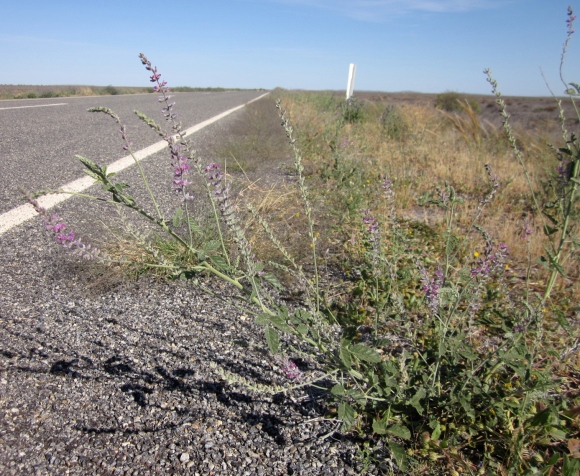Now that you have had a chance to get up to date with the Beckler’s Botanical Bounty Project…..[What, you don’t know what I am talking about? Have a look in the Beckler’s Botanical Bounty category to the right of this page]……I am going to introduce you to the group of flowers that I am painting.
They are Cullens.
Everyone knows Banksias and Grevillias, and many of us have them growing in our gardens. But whenever I say that I am painting Cullens people have a polite but blank look. There are 4 species of Cullen on Beckler’s list. [Hermann Beckler collected plants while in Menindee on the Burke and Wills Expedition. It is his list of 120 plants that we are trying to replicate.] So, let me show you my beauties.
The first is Cullen discolor. This is the species that I have been painting. I will show you what I have been up to in later posts. C. discolor is very prostrate, growing out from a central point. [Botanical practice writes the Latin names in italics, capitalises the genus name, in this case Cullen, and allows it to be abbreviated after the first mention.]



The next, Cullen australasicum was so difficult to find. Although it is an upright bush, I could not see it growing anywhere. Then, as it goes with these things, I saw bushes of them all along the Menindee/Broken Hill Road as we were leaving!


The third, Cullen pallidum, is probably the most showy and, while being no relation, reminds people of a lavender.


You have probably noticed a couple of defining characteristics of this genus. Firstly, the flower places it in the pea family, Fabaceae. You can see those distinctive ‘wings’ and ‘keels’ that pea flowers have. However, they don’t have pods like eating peas do. You can see how the seeds are still in their furry individual pods.
Secondly you will have noticed the leaves. Cullens have 3 leaflets (trifoliate), two lateral ones and the third that is a little distant from them. The leaflets have definite veins, which give the leaves a lovely folded look ~ wonderful to paint! They are also quite textured. This is protection from the harsh inland Australian sun.
While I had trouble finding these species, they are not rare in the area around Menindee, NSW. It is more a matter of knowing where to look, or plain luck 🙂 and some seasons are better than others. In 2011 I saw many, large plants of C. pallidum but they haven’t been so prolific in later years. However, Cullens in Victoria are now rare, with many species endangered.

7 replies on “Cullen, Australian wildflowers”
What beautiful closeups. I have a weakness for anything purple. These are lovely.
I’m fascinated by the color of the soil. It has a copper tinge to it.
LikeLike
I find it interesting that such showy plants can be unknown. C. discolor is low growing and easily missed, but some of the other species, in good seasons, are quite obvious.
The red soil is wonderful ~ an iconic part of inland Australia. Very sandy though.
LikeLike
I’m hopeless with names, but the australasicum in the closeup look almost like snapdragons. Does this mean snapdragons are also in the pea family?
LikeLike
Not sure, I will do some research and get back to you. My thoughts are that it isn’t.
LikeLike
Okies. Will be interested to know what you discover. 🙂
LikeLike
Reblogged this on Anne Lawson and commented:
Quite a few of you looked at my post about finishing my Cullen pallidum painting. 🙂 One of you had found the link to my earlier post about the Cullen flowers. I thought it would be worth reposting it, as the Cullen flowers are not widely known.
LikeLike
[…] common to the area, depending on the season, and were collected by Beckler. I have written about the genus here. My ability to paint Cullens developed as I went along. So, if I had time I would repaint the […]
LikeLike